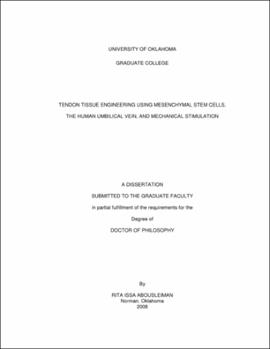| dc.contributor.advisor | Sikavitsas, Vassilios I | |
| dc.creator | Abousleiman, Rita Issa | |
| dc.date.accessioned | 2019-04-27T21:27:15Z | |
| dc.date.available | 2019-04-27T21:27:15Z | |
| dc.date.issued | 2008 | |
| dc.identifier | 99206323902042 | |
| dc.identifier.uri | https://hdl.handle.net/11244/318725 | |
| dc.description.abstract | The umbilical cord is a biological tissue that is readily available and is usually discarded. Previous studies suggested the use of the Human Umbilical Vein (HUV) as an acellular vascular grafting material. In this study, we attempt to develop a tissue engineered tendon model using HUVs as scaffolds coupled with Mesenchymal Stem Cell (MSC) therapy and with mechanical stimulation. HUV sections were dissected from fresh human umbilical cords, decellularized, and seeded with rat MSCs. A special bioreactor was designed to house and dynamically stimulate the constructs for periods of one and two weeks. Samples cultured without dynamic stimulation were used as controls. Dynamic stimulation resulted in 8 fold higher proliferation rates and significantly stronger (156%) and stiffer (109%) constructs compared to the controls. Microscopically, dynamically stimulated samples showed parallel orientation of collagen fibers and spindle-shaped cell nuclei mimicking the morphology of native tendons. | |
| dc.description.abstract | When higher seeding densities, of 5 and 10 million cells/ml, were attempted extracellular matrix of the HUV significantly degraded, constructs had weaker mechanical properties, and cell bodies lysed after 2 weeks of culture. These results indicated that, for the current design, cells were not able to survive at original seeding concentrations higher than 5 million cells/ml. The limiting seeding density for unstimulated samples was calculated based on glucose consumption rates to be 3 million cells/ml. This value increases for stimulated constructs due to the enhancement of nutrients' transport through convective flow. The documented findings are limited by the design parameters and experimental protocols followed in this study. Variation of these parameters, including HUV thickness, decellularization techniques, or stimulation scenarios, will significantly affect the results. | |
| dc.format.extent | 143 pages | |
| dc.format.medium | application.pdf | |
| dc.language | en_US | |
| dc.relation.requires | Adobe Acrobat Reader | |
| dc.subject | Guided tissue regeneration | |
| dc.subject | Tissue engineering | |
| dc.subject | Tendons--Wounds and injuries--Treatment | |
| dc.subject | Mesenchymal stem cells | |
| dc.title | Tendon Tissue Engineering Using Mesenchymal Stem Cells, the Human Umbilical Vein, and Mechanical Stimulation | |
| dc.type | text | |
| dc.type | document | |
| dc.thesis.degree | Ph.D. | |
| ou.group | College of Engineering::School of Chemical, Biological and Materials Engineering | |
